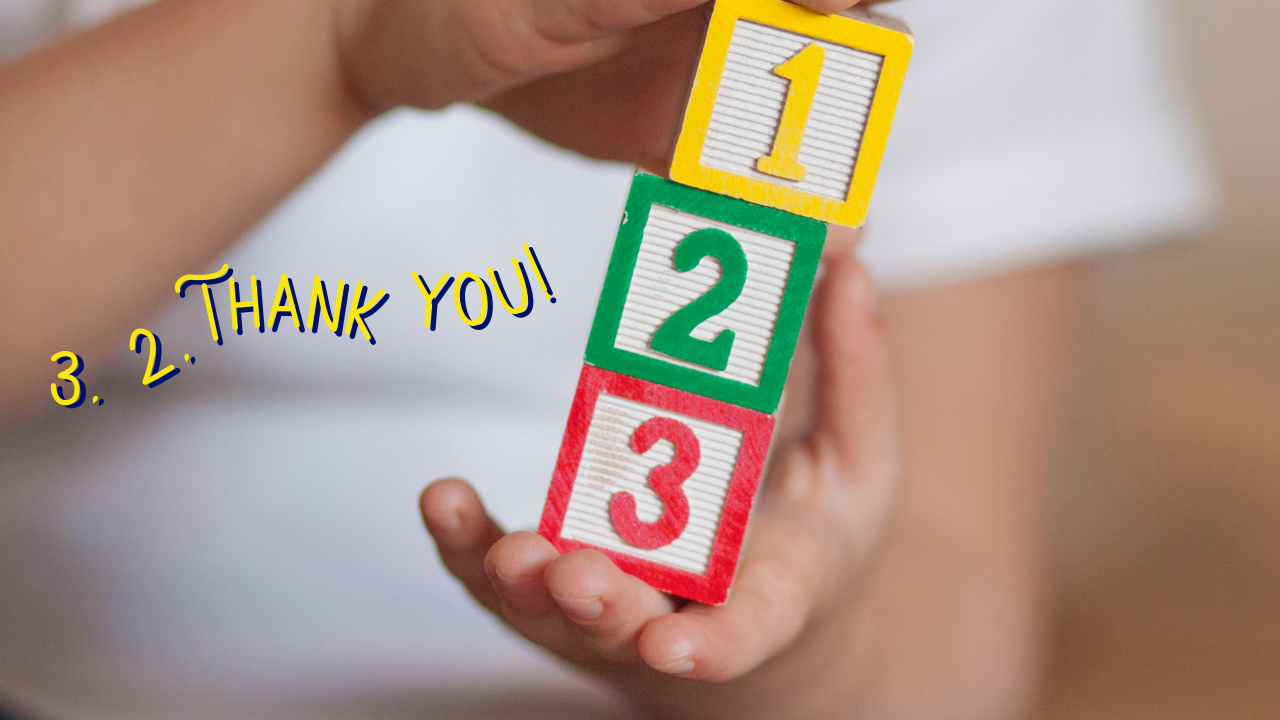3, 2, Thank You!
May 18, 2023
How do you discipline your children? Certainly, infants and very young children don’t need any discipline. Instead, the focus at these ages is on modeling good behavior and steering them away from danger. However, as your child approaches age 2, they start having more of a sense of independence and trying out new behaviors, some of which you may not want to continue. In preparation for this developmental stage, I introduce the concept of behavioral consequences early, teaching children that each behavior they choose has a consequence. If you start as soon as your infant starts walking, you will already have a system in place when they reach this tricky stage.
My favorite strategy for disciplining young children involves providing choices. And I conceptualize it more as teaching than disciplining. Your child’s verbal comprehension skills (understanding spoken words) are well-developed already. So even if they do not have a lot of verbal expressions (the ability to say words) yet, they can understand what you say and the choices you provide very well. Giving your child a choice helps them feel empowered rather than like their parents are dictators. Something as simple as, “Would you like to read this book or that book before your nap today?” helps your child develop independence and gets them used to the concept of making choices.
Using choices as a discipline technique comes into play when your child says they do not want to do something you expect them to do. For example, when you let them know it’s time to head upstairs for their nap, and they, in turn, let you know they don’t want to take a nap today. First, I would explain why you asked them to do the given behavior (napping), such as, “Your body needs rest so you will have enough energy for our fun afternoon outing. Let’s head up to nap now.” If they don’t seem tired at all, you might consider offering to read a few more stories before nap. But assuming your child seems ready for their nap and this resistance is an example of “testing the limits” of their independence, I would then provide the clear choice, “You can walk up the stairs to nap, or I can carry you.”
When offering choices, you’re still kindly speaking to your child, but you are clearly communicating that you are in control and the desired behavior (nap time) will happen while giving them a choice to make a good decision and walk up on their own. I would then start counting “3, 2, 1,” and if they have not started walking up the stairs by 1, I would say, “Ok, then I’ll carry you up,” and pick them up and snuggle or fly them like a plane to keep the mood lighthearted before nap.
Some people count up to 10, but 3 counts are plenty of time for your child to make a decision. Some people count upward from 1 to 3, but it’s more apparent to kids that something will happen after 1 when counting downward. They know there’s a number 4 after the number 3, but they’re not yet aware of negative numbers (and often not even aware of 0), so 1 indicates the end of the line.
Here’s my favorite part about counting down from 3: When your child gets the hang of it and knows you’re serious about the choice (walking or being carried up to nap in this example), they’ll get those feet moving, usually after a teeny bit of dilly-dallying, so you end up saying, “3, 2, Thank You!” That way, you never have to say 1. Ending your count on 2 makes it rhyme nicely with thank you and keeps the mood positive.
You must use this strategy consistently for it to work. That doesn’t mean using it universally whenever your child does something you don’t like. Instead, use it only for behaviors for which there is a clear next step that you want to be taken: “Please climb in the car, or mommy will help you in;” “Please hop out of the bath or mommy will help you out;” “Please give that back to your sister, or mommy will help you give it to her.” Using this approach consistently means when they have refused to do something you have asked them to do, you provide a choice, start counting down from 3, and consistently follow up with the consequence if your child does not choose the favorable option. There’s no further discussion. Instead, set a clear consequence, make sure they hear the consequence, start counting, and hopefully, you’ll get to say a big “Thank You!” with a big smile after they do the desired behavior.
As you can see, in the early years, this is a physical approach (in a very gentle way; please do not confuse this with physical punishment) in that you’re helping your child move their body. However, when used consistently, kids learn to make the good choice provided by you because they know if you start counting, you’re serious about making the request happen. Over time, your child will learn to make good choices and respect your words, so this becomes a simple, verbal approach to discipline. Start early with your one-year-old so you won’t have to carry your heavy four-year-old around whenever they refuse to follow your requests.
Using this technique consistently means by the time your munchkin starts kindergarten, they’ll be cooperative and helpful at home and in the classroom. That age five/kindergarten milestone is the first I work toward when parenting young children using my 5 C’s parenting framework (see The 5 C’s to Amazing Parenting and Love, Balance, and Problem Solving). Do you feel like your child listens to you? Do you feel like they are developing independence while also learning to follow family rules? If you need help in those areas, try 3, 2, Thank You! with your kiddo this week, and let this countdown approach start working for you.
3, 2, Thank You! is part of the Choices & Checkpoints category in my 5 C’s parenting framework. To find more posts in this category, use the category search menu on the right of the screen. Keep up the good work on your amazing parenting journey!

P.S. For more real-life examples of how to use 3, 2, Thank You! to improve your day-to-day parenting experience, check out my free download, How to Make Dining Out With Your Children Enjoyable!
If you’re looking for some inspiration on easy-to-carry toys to keep your young ones entertained while you’re waiting for your meal to arrive, check out my Treasures - Dining Out page. I have a whole category of products to help make your restaurant experience more enjoyable.




